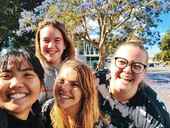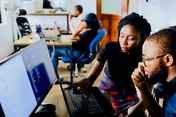Ask WHO should be part of this
A Community Child and Youth Well-being Survey can help bring your community together and make it stronger over time. It provides opportunities to build on existing community networks (such as child and youth or broader well-being collaboratives) and data initiatives (e.g., surveys about the general population or specific contexts such as school climate).
Advisory Group
One of the best ways to secure the kind of support that will see the project through start-up to maturity is to ask key individuals to take on ongoing advisory roles for its duration. Think about whose support will help overcome barriers, influence others to collaborate and raise the project’s profile.
You are asking this group to contribute their insights, perspectives, connections and profile to the project – not necessarily climb into the trenches with you. Their feedback can serve as an invaluable compass check on your strategic direction. This is also a good place for someone who might otherwise be a critic of the project to channel their energy and insights into making the project better.
If you target your requests for involvement to the most senior individuals in each organization, you elevate the importance of the work for everyone involved. Even if that individual is not able to participate, they are likely to assign the task to a trusted colleague and maintain an interest in the project as it progresses. While youth might be advisory group members, especially if they lead youth organizations, they may be better engaged in the Steering Committee and in specific implementation activities for a hands-on approach. A group of six to 12 members is a manageable size.
The following hints may help you successfully invite members:
- Refine your pitch. Why is the project important, who will it help and who is already committed?
- Shamelessly drop names. For example, “Amanda So-and-So of XYZ Corporation has agreed to chair the group” or “We have asked Mohammed Up-and-Comer to share his thoughts on community mobilization with us.”
- Be clear about the time commitment. For example, “We are planning three 90-minute Zoom calls – one in the planning stages, one part-way through the survey period and one when the preliminary results are available. You will be supplied with a short briefing package in advance of each meeting that will not take more than a half hour to read.”
- Be flattering regarding why they are being asked. For example, “We think your knowledge of the local foundation community will be particularly helpful in identifying opportunities for collaboration.”
- Make the request in person, over the phone or through a trusted intermediary if possible, then follow up by email. For youth participants, it is important that they not only understand what they will get from the experience, but also the potential broader impact of their participation and contributions.
Steering Committee
This group is more hands-on. The same advice applies about how to ask them to participate, but the time commitment is more extensive and the kind of work you are asking them to do is oriented more toward operations.
One of the single biggest determinants of overall project success is the team you assemble to carry it forward. It is useful to organize the leadership team for the Community Child and Youth Well-being Survey (the Steering Committee) according to the different stakeholders and the different kinds of work you are asking its members to do, such as community outreach, communications and media, youth participation, research, funding and financial management. These people will be signatories to the project charter and have decision-making influence as the project progresses.
Consider the following categories of supporters as a starting point:
- Partners in the project’s delivery
- Contributors of resources, including funding
- Community animators and promoters
- Participants in the survey
- People who will help make sense of the data
- Users of the data (include government, community organizations, academia and business, and users across sectors, such as children and youth, health, social services, education, economic development and recreation)
- Proponents of the project overall
In some cases, you will be able to draw on structures that are already in place. Established coalitions or planning tables for and with children and youth have successfully led the Community Child and Youth Well-being Survey in some communities and are a natural source of leadership. In other communities, the survey can be an opportunity to forge new relationships to establish a “backbone” steering group that is substantial enough to gather resources, share responsibilities and engage young people and other data users, but small enough to be agile as they build new relationships.
Core project team
These are the people whose day-to-day jobs make the project run smoothly. They might include a project director, communications/outreach coordinator and research coordinator, for example. Usually these are paid positions and can be funded through the project budget or as in-kind contributions from partner organizations. The team may also need to call on financial and technology (e.g., web site/online survey) experts. Altogether, the work effort involved in the survey is equivalent to about one full-time person.
The project team takes direction from the Steering Committee and supports the engagement of the Advisory Group. Typically, the project director will sit on the Steering Committee as a full participant and act in an ex-officio role with the Advisory Group. If space and time allow, it is useful for all core project team members to attend all meetings to optimize communication.
Survey participants
Young people, the intended beneficiaries of the survey, should play key roles right from the start in the planning and leadership of the survey and have opportunities to participate all along the data cycle. They might contribute in any area of focus, though are typically most engaged in the survey promotion and in sense-making and action-planning. Their involvement ensures the project’s credibility, optimizes its effectiveness and prevents it from becoming tone-deaf to the very people it means to serve.
The age of young people who participate in the project should mirror the age range that is surveyed. The Community Child and Youth Well-being Survey is designed for participants ages 9 to 18 and should survey the full age spectrum. However, without targeted effort to include younger and older youth in roles and as survey participants, those ages 14 to 16 are most likely to participate. Particular effort is needed to include the youngest age group as survey participants and to take up other roles.
The sample project calendar in this toolkit suggests specific roles for young people. A minimum of two young people should be supported to participate on the Steering Committee as Youth Connectors, but 20 per cent of the total number is a basic rule of thumb for representation and will provide for more diversity and help. The project team may also create youth roles such as Youth Animators (alternatively, Youth Ambassadors) to take on outreach and engagement activities. These peer-to-peer efforts can create a powerful platform to talk about well-being.
All young people who have roles (as Steering Committee Connectors, Animators and potentially youth event participants) should be provided with honoraria, pay, or recognition for school volunteer hour requirements, depending on the role requirements and young peoples’ preferences. Their direct costs, such as transportation, should also be covered. Typically, adults who volunteer as Advisors or Steering Committee members are in paid positions for which such participation fits with their job roles; others may have paid project positions. Young people are typically not in similar positions, and their time and effort should be valued with compensation.
See Appendices for sample job descriptions of youth roles and a sample thank you letter to youth contributors.
Research/data partner
Some communities have accessed a Research and Evaluation Task Force already existing in their networks to assist in survey planning and data analysis. Even with access to such a resource, you will most likely need to contract a research/data partner to undertake a number of tasks related to survey preparation and data collection and reporting. This capacity may be available within a partner such as a social planning table, within a local university or college or working as a freelance data scientist. The research/data partner will advise on and deliver the following tasks:
- Assist in determining the geographic boundaries of the survey and map them against census data if desired
- Determine the target sample and profile
- Finalize the survey questionnaire with any of the optional modules and demographic questions you wish to incorporate
- Send the questionnaire, consent forms and other materials (e.g., web content, core communications to survey participants, prize draw) for ethics approval, if required
- Create the front-end survey delivery platform and set up the back-end to capture the data
- Test survey functionality
- Periodically report to the project team on the progress of survey response numbers (overall and by demographics)
- Close the survey
- “Clean” the data to remove partial responses and errors and exclude responses if an associated consent form is not provided
- Create a raw database with privacy protection/suppression
- Administer a Data Sharing Agreement and transfer the cleaned database
- Prepare a technical report of the results based on key parameters
- Analyze more deeply any areas you want to focus on
- Support data communications and sense-making activities
Partners in the project’s delivery
The Community Child and Youth Well-being Survey is a platform for a broad range of stakeholders to come together to improve the well-being of young people, working in ways that often cannot be accomplished by a single sector or organization or by adults working apart from young people. This toolkit suggests many roles for a variety of groups and individuals. Ideally, you will identify and involve many of them early in the process. The more inclusive your reach, the more likely you are to achieve meaningful results that generate real change, and the more credibility the effort will have with decision-makers, data users and the general population. It will enable a shared, intergenerational understanding of child and youth-related issues and a coordinated approach to developing strategies that address them.
Here are some categories of potential partners to consider:
- Youth-specific groups and non-affiliated young people
- Local governments: town and municipal, elected and administrative, potentially along with provincial and federal representatives
- Schools, school boards, health units, team coaches and parent groups
- Community advocates (e.g., environmental, housing, poverty, health and well-being)
- Service organizations (e.g., United Way, Rotary Clubs, YMCA)
- Social planning tables
- Your local community foundation and other philanthropic organizations
- Cultural community representatives (e.g., Indigenous, Black, newcomer, LGBTQ2S+)
- Media (e.g., newspapers, bloggers, local radio and TV)
- Large employers and unions
- Chambers of Commerce and other business associations
- Influencers and change agents
- Universities and community colleges (especially researchers in related fields)
Consider framing meeting requests with their organizations as opportunities for you to get advice on an important idea. It is a strategy that almost always works to open sticky doors. Or ask to provide a briefing at an event that is already scheduled, like a board meeting, conference or quarterly update. This is where a Youth Connector on your Steering Committee can play a role. While expressing enthusiasm about the project’s potential, make it clear that their organization’s input will help frame its final shape. Listen carefully and be prepared to modify your plans depending on what you hear. Follow up to say thank you and reinforce key points from the meeting. And keep a comprehensive list of who you reach out to and the follow-up actions. Being on top of details like these goes a long way to inspiring confidence and avoids missed or repeat communications that can get in the way of your project being taken seriously.
The time you invest upfront – reaching out, sharing information, seeking counsel and building support with these groups – will pay dividends throughout the project in more ways than you can imagine. Being open to real input will strengthen the project, help you identify better strategies and overcome obstacles down the road. Involving people early helps them feel invested in the project and more willing to contribute to its ultimate success.
To that end, you should set aside a significant period of time before the project officially gets underway to connect directly with as many stakeholders as possible, expanding from a core group of committed stakeholders. As the project rolls out and you move through the stages of the data cycle, you can ask these stakeholders to do specific tasks, like share the survey information or recruit young people to participate.
.jpg)
Once the project’s Steering Committee and funders (and Advisory Group, if formalized) are confirmed, it is a good idea to prepare a formal project charter. Project charters are documents that affirm who is involved and what their responsibilities are, along with the project’s vision, scope and key deliverables. They can also describe the mechanism by which these partners work together and resolve disputes. Using “youth-friendly” terms and language, reviewed by young people, will help ensure the charter and other project documents are accessible to youth involved in project leadership.
.jpg)





































